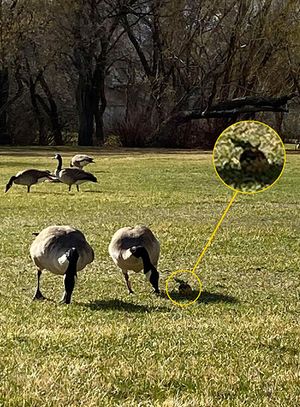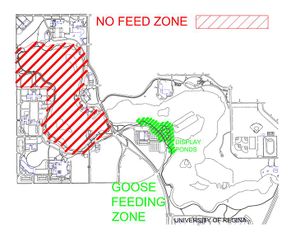Goose Cakes: Difference between revisions
No edit summary |
|||
| Line 10: | Line 10: | ||
==<b>Introduction</b>== | ==<b>Introduction</b>== | ||
[[File:gooseimage1.jpg|300px|right|thumb|Goose Cupcake, Confirmed]] | |||
<p>Goose Cakes deploys the digital as a site to consider our relationships with the non-human. The project is based on a series of field notes and writing compiled collaboratively throughout the months of quarantine as we attempted to learn more about geese in order to gift them a cupcake specific to their dietary needs and wants. This work will conclude with a live-streamed artist talk and goose feeding on July 19th, 2020. | <p>Goose Cakes deploys the digital as a site to consider our relationships with the non-human. The project is based on a series of field notes and writing compiled collaboratively throughout the months of quarantine as we attempted to learn more about geese in order to gift them a cupcake specific to their dietary needs and wants. This work will conclude with a live-streamed artist talk and goose feeding on July 19th, 2020. | ||
| Line 49: | Line 49: | ||
==On Goose Diet== | ==On Goose Diet== | ||
{| border=1 style="text-align:center;" | {| border=1 style="text-align:center;" | ||
| <b>Safe</b> || <b>Unsafe</b> || <b>Notes/Goose Preference</b> | | <b>Safe</b> || <b>Unsafe</b> || <b>Notes/Goose Preference</b> | ||
Revision as of 18:23, 5 July 2020
Introduction

Goose Cakes deploys the digital as a site to consider our relationships with the non-human. The project is based on a series of field notes and writing compiled collaboratively throughout the months of quarantine as we attempted to learn more about geese in order to gift them a cupcake specific to their dietary needs and wants. This work will conclude with a live-streamed artist talk and goose feeding on July 19th, 2020.
Beginning with observation of geese near Wascana Lake in Regina, a man-made lake hosting a migratory bird sanctuary, the project followed Simon’s own COVID influenced migration to Toronto. The second half of this project was then marked by an active search for the geese in this second city, and an interest in the implications of the new patterns of movement COVID has introduced to our lives.
Locations
Wascana Park, Regina
This project began somewhere in the early weeks of the COViD-19 pandemic’s initial surge in North America. I’d gone back to Saskatchewan to self-isolate, and after about a week or so it dawned on me that the only other ‘people’ that I’d really spent time with other than my partner were the Canada geese that populate Wascana Lake, Regina’s man-made water feature that dominates much of the central and southern parts of the city. The apartment that I was staying at was near a large nesting ground (Sleeping area? Hangout?) for the geese, and every morning at around 5 am the two of us would awaken from the distant honking overhead. A chorus that once unconsciously signaled the arrival of spring in the backdrop of day-to-day life had, in the absence of ‘activity’, or ‘life’, as I usually understood it, bubbled to the surface of my recognition.
This was one of the odd side-effects on social life that the pandemic seemed to have had on cities throughout the world. In the quietude of empty streets emerged birdsong, animals from the surrounding area, and common ‘pests’ like rats in search of human waste that had suddenly disappeared.[1] The geese in Regina, however, arrive perennially. It was as though, rather than witnessing a re-emergence, it was instead my attention to detail that changed. Locked away inside (like most others who have the privilege of doing so) my daily walks became requisite for the maintenance of my own sanity. And, in my moments of boredom between anxiety, I started to notice more than did before: I walked across the frozen lake in March, and took note of the way the top of the ice sheet gradually melted in the day before freezing again at night. I observed the daily patterns of my neighborhood geese, who gathered nearby in the mornings before flying to a bay across the lake to rest at night. I stood and watched as the flock, hundreds large, organized smaller groups that marched in unison before flying away, like peeling an orange in sections. I watched the geese throw their necks up in a flailing stretch and beat their wings against their bodies. I tried to recognize their different types of honks, hisses, and mumbles, and wondered about their relationships.
As the spring unfolded, the geese spread from their initial icy landing pad. The single large flock dispersed in search of slowly greening grass in the surrounding municipal park, and they began nesting eggs in the goose-specific islands in the southeast portion of the lake: Goose Island and Tern Island, in the Wascana Lake Migratory Bird Sanctuary.
The coexistence of the animals in the sanctuary (among them, Mallards, Sandpipers, Black Tern, three varieties of Grebe, Pelicans, Loons, and Beavers, to name a few[2]) has a tinge of strange irony to me. The lake itself is entirely artificial, and only exists because of the damming of Wascana Creek in 1883. As a self-described (small) city kid, it never really dawned on me that the lake could inhabit that much life, and, quite honestly, be that beautiful. Citizens of Regina will be familiar with the common trope that Wascana Lake is really more of a goose toilet bowl than it is a source of clean fresh water. In fact, the smell emanating from the lake got so bad in the early 2000s that it spawned a city project, the ‘Big Dig’[3], to deepen it and improve the flow of oxygen. Over the last few years, yet another ungainly tradition: the die-off of invasive carp, whose large bodies sometimes float to the surface in the thousands after the ice melt because their oxygen is cut off during the winter freeze-over.[4] Wascana Lake’s unfortunate reputation has even spawned satires like Swamp Fest, an annual music festival whose lore features the mascot T. A. B. (Toxic Algae Blob), a creature borne out of Wascana’s mysterious and poisonous waters.[5] Given this history, my newfound fascination with the lake as a genuinely picturesque biodiverse ecology was something of a surprise.
This surprise spurred me to get to know the geese on a more intimate level. So, as they unfurled their wings and began to feed, I planned a gift for them in conversation with Rowan and the rest of the What You See crew. Vegan suet, it turns out, is commonly used as a binding agent to make three dimensional shapes out of bird seed, so I made plans to make goose cupcakes, a decorated cupcake made from seed and other goose-friendly foods.
For whatever reason, though, the geese didn’t like the cupcake at all. They completely ignored it in favor of the plentiful grass that surrounded them."

Grenadier Pond, Toronto

[history of the pond] We tried to guess which geese were paired up, but it was hard to tell. They seemed to aggress each other equally.
lorum ipsumlorum ipsumlorum ipsumlorum ipsumlorum ipsumlorum ipsumlorum ipsumlorum ipsumlorum ipsumlorum ipsumlorum ipsumlorum ipsumlorum ipsumlorum ipsumlorum ipsumlorum ipsumlorum ipsumlorum ipsumlorum ipsumlorum ipsumlorum ipsumlorum ipsumlorum ipsumlorum ipsumlorum ipsumlorum ipsumlorum ipsumlorum ipsumlorum ipsumlorum ipsumlorum ipsumlorum ipsumlorum ipsumlorum ipsumlorum ipsumlorum ipsumlorum ipsumlorum ipsumlorum ipsumlorum ipsumlorum ipsumlorum ipsumlorum ipsumlorum ipsumlorum ipsumlorum ipsumlorum ipsumlorum ipsumlorum ipsumlorum ipsumlorum ipsumlorum ipsumlorum ipsumlorum ipsumlorum ipsumlorum ipsumlorum ipsumlorum ipsumlorum ipsumlorum ipsumlorum ipsumlorum ipsumlorum ipsumlorum ipsumlorum ipsumlorum ipsumlorum ipsumlorum ipsumlorum ipsumlorum ipsumlorum ipsumlorum ipsumlorum ipsumlorum ipsumlorum ipsumlorum ipsumlorum ipsumlorum ipsumlorum ipsumlorum ipsumlorum ipsumlorum ipsumlorum ipsumlorum ipsumlorum ipsumlorum ipsumlorum ipsumlorum ipsumlorum ipsumlorum ipsumlorum ipsumlorum ipsumlorum ipsumlorum ipsumlorum ipsumlorum ipsumlorum ipsumlorum ipsumlorum ipsumlorum ipsumlorum ipsumlorum ipsumlorum ipsumlorum ipsumlorum ipsumlorum ipsumlorum ipsumlorum ipsumlorum ipsumlorum ipsumlorum ipsumlorum ipsumlorum ipsumlorum ipsumlorum ipsumlorum ipsumlorum ipsumlorum ipsumlorum ipsumlorum ipsumlorum ipsumlorum ipsumlorum ipsumlorum ipsumlorum ipsumlorum ipsumlorum ipsumlorum ipsumlorum ipsumlorum ipsumlorum ipsumlorum ipsumlorum ipsumlorum ipsumlorum ipsumlorum ipsumlorum ipsumlorum ipsumlorum ipsumlorum ipsumlorum ipsumlorum ipsumlorum ipsumlorum ipsumlorum ipsumlorum ipsumlorum ipsumlorum ipsumlorum ipsumlorum ipsumlorum ipsumlorum ipsumlorum ipsumlorum ipsumlorum ipsumlorum ipsumlorum ipsumlorum ipsumlorum ipsumlorum ipsumlorum ipsumlorum ipsumlorum ipsumlorum ipsumlorum ipsumlorum ipsumlorum ipsumlorum ipsumlorum ipsumlorum ipsumlorum ipsumlorum ipsumlorum ipsumlorum ipsumlorum ipsumlorum ipsumlorum ipsumlorum ipsumlorum ipsumlorum ipsumlorum ipsumlorum ipsum
The Virtues of Geese; On Goose/Human Relations
We look at animals and in the silence between us we insert ourselves, or rather the ways they are more or less like us. I could say: geese are more blundering, less wise, show more aggression, less tranquility. This framework presents itself in the first place because humans are aggressive too! We’re loud, we lash out. We socialize in groups, we marry for life (or rather, idealize the concept). Given divorce statistics, perhaps geese (who pair up for life in their second year) are more fidelitous. Geese display perseverance. Dignity? Not so much. Charisma? Hard to say. Are they introspective? They certainly don’t seem to overthink.
This impenetrability leaves ample room for projection. The geese become whatever we need from them: a reason to risk a walk through the green pathways of High Park, one of the only spaces I’ve found in this city where you can forget where you are. I’m looking for geese, and when I find them, they are not in any of the park's secluded areas. They are in a group of about 20, directly beside an occupied picnic table, claiming the terrain between a main walking path and the water of Grenadier Pond. We are drawn to the geese. I watch children risk their fingers to throw them grass and seeds. Are the geese drawn to us? Our activity certainly doesn’t seem to disturb them. Did you know, on the Canadian Goose wikipedia page, there is a whole section reserved for “Relationship with humans?"
Within the motions of gift-giving, acceptance itself implies awareness of involvement in the act, with all the meaningful associations that go along with it. Giving and receiving each stand as an active role. I am sure the geese do not see it this way, but regardless, we have found a method of interacting with them that provides an illusion of mutual receptivity. I know for all the enjoyment i’ve derived from it, our efforts towards this goal of goose-human recognition are futile, so why not write it plainly here:
Thank you geese for reminding us of the continuation of cycles tied to the seasons, and for decentring the moment we are in; thank you for your levity. From what I understand, global warming and human intervention has and will disrupt this too, but for now, thank you geese for your steadiness. Thank you geese for being here at the expected time, despite everything.
On Goose Diet
| Safe | Unsafe | Notes/Goose Preference |
| Grass | the natural staple of their diet | |
| Bread | do not feed them plain bread! | |
| Carrots | disinterest | |
| Sesame Seeds (unsalted) | actively enjoy | |
| Grass | the natural staple of their diet | |
| Bread | do not feed them plain bread! | |
| Carrots | disinterest | |
| Sesame Seeds (unsalted) | actively enjoy | |
| Grass | the natural staple of their diet | |
| Bread | do not feed them plain bread! | |
| Carrots | disinterest | |
| Sesame Seeds (unsalted) | actively enjoy |
Recipes

Goose Test Cupcake 1
Success: 2/10
- grass (blended)
- raspberries (whole)
- arugula
- vegan suet